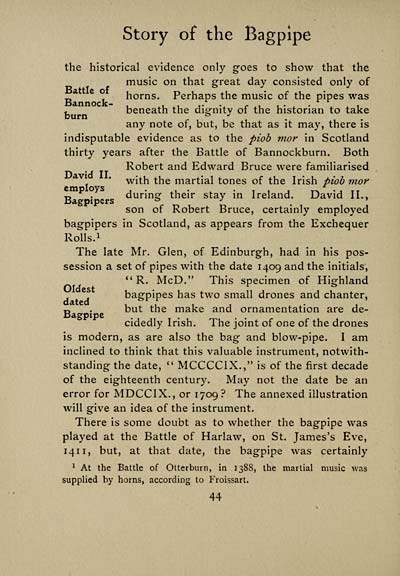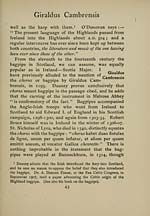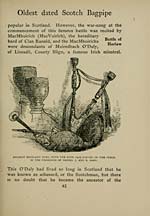Inglis Collection of printed music > Printed text > Story of the bagpipe
(70) Page 44
Download files
Complete book:
Individual page:
Thumbnail gallery: Grid view | List view

Story of the Bagpipe
the historical evidence only goes to show that the
music on that great day consisted only of
a e horns. Perhaps the music of the pipes was
« beneath the dignity of the historian to take
any note of, but, be that as it may, there is
indisputable evidence as to the piob mor in Scotland
thirty years after the Battle of Bannockburn. Both
Robert and Edward Bruce were familiarised
avi * with the martial tones of the Irish piob mor
T, . durinsf their stay in Ireland. David II.,
Bagpipers & J '
son of Robert Bruce, certainly employed
bagpipers in Scotland, as appears from the Exchequer
Rolls. 1
The late Mr. Glen, of Edinburgh, had in his pos-
session a set of pipes with the date 1409 and the initials,
"R. McD." This specimen of Highland
" bagpipes has two small drones and chanter,
D . but the make and ornamentation are de-
Bagpipe
cidedly Irish. The joint of one of the drones
is modern, as are also the bag and blow-pipe. I am
inclined to think that this valuable instrument, notwith-
standing the date, " MCCCCIX.," is of the first decade
of the eighteenth century. May not the date be an
error for MDCCIX., or 1709? The annexed illustration
will give an idea of the instrument.
There is some doubt as to whether the bagpipe was
played at the Battle of Harlaw, on St. James's Eve,
141 1, but, at that date, the bagpipe was certainly
1 At the Battle of Otterburn, in 1388, the martial music was
supplied by horns, according to Froissart.
44
the historical evidence only goes to show that the
music on that great day consisted only of
a e horns. Perhaps the music of the pipes was
« beneath the dignity of the historian to take
any note of, but, be that as it may, there is
indisputable evidence as to the piob mor in Scotland
thirty years after the Battle of Bannockburn. Both
Robert and Edward Bruce were familiarised
avi * with the martial tones of the Irish piob mor
T, . durinsf their stay in Ireland. David II.,
Bagpipers & J '
son of Robert Bruce, certainly employed
bagpipers in Scotland, as appears from the Exchequer
Rolls. 1
The late Mr. Glen, of Edinburgh, had in his pos-
session a set of pipes with the date 1409 and the initials,
"R. McD." This specimen of Highland
" bagpipes has two small drones and chanter,
D . but the make and ornamentation are de-
Bagpipe
cidedly Irish. The joint of one of the drones
is modern, as are also the bag and blow-pipe. I am
inclined to think that this valuable instrument, notwith-
standing the date, " MCCCCIX.," is of the first decade
of the eighteenth century. May not the date be an
error for MDCCIX., or 1709? The annexed illustration
will give an idea of the instrument.
There is some doubt as to whether the bagpipe was
played at the Battle of Harlaw, on St. James's Eve,
141 1, but, at that date, the bagpipe was certainly
1 At the Battle of Otterburn, in 1388, the martial music was
supplied by horns, according to Froissart.
44
Set display mode to: Large image | Transcription
Images and transcriptions on this page, including medium image downloads, may be used under the Creative Commons Attribution 4.0 International Licence unless otherwise stated. ![]()
| Special collections of printed music > Inglis Collection of printed music > Printed text > Story of the bagpipe > (70) Page 44 |
|---|
| Permanent URL | https://digital.nls.uk/94510016 |
|---|
| Description | Scottish and English songs, military music and keyboard music of the 18th and 19th centuries. These items are from the collection of Alexander Wood Inglis of Glencorse (1854 to 1929). Also includes a few manuscripts, some treatises and other books on the subject. |
|---|
| Description | The Glen Collection and the Inglis Collection represent mainly 18th and 19th century Scottish music, including Scottish songs. The collections of Berlioz and Verdi collected by bibliographer Cecil Hopkinson contain contemporary and later editions of the works of the two composers Berlioz and Verdi. |
|---|

